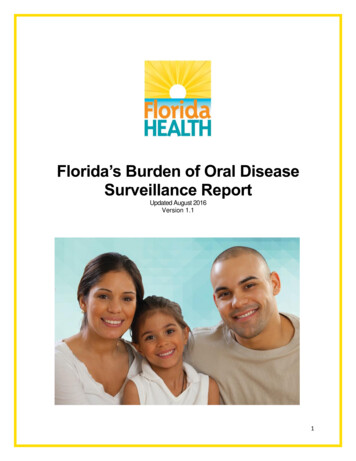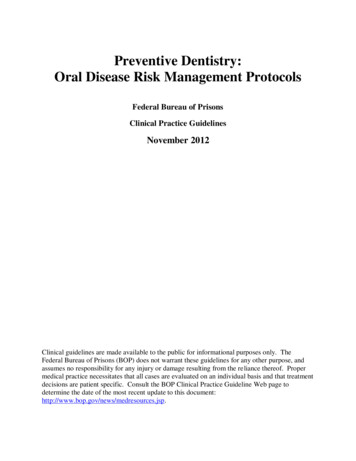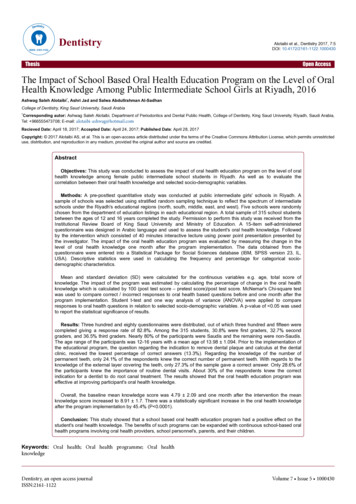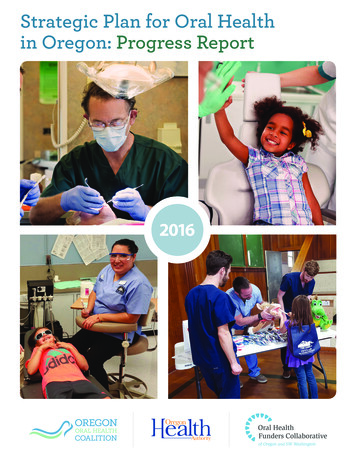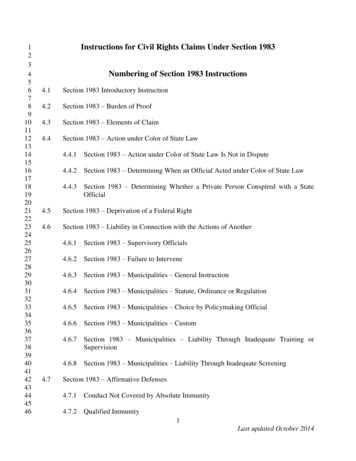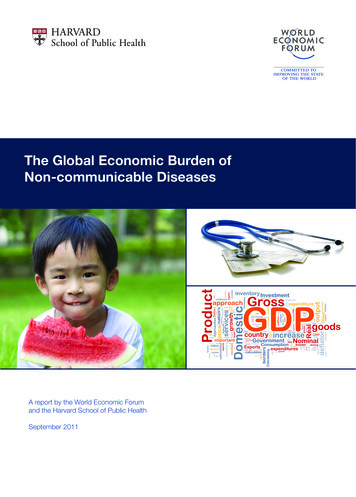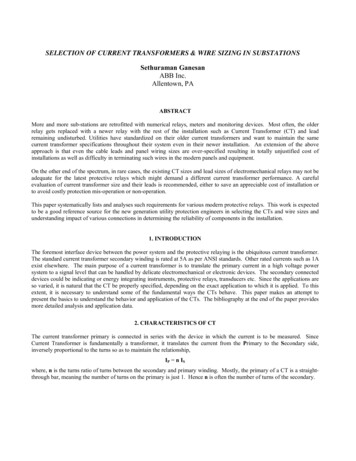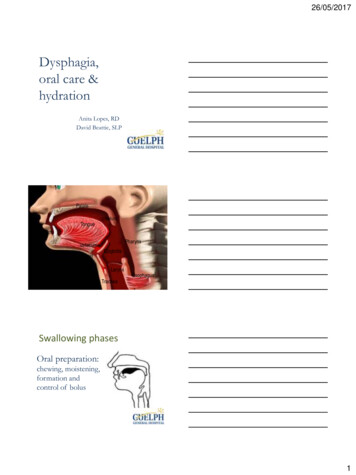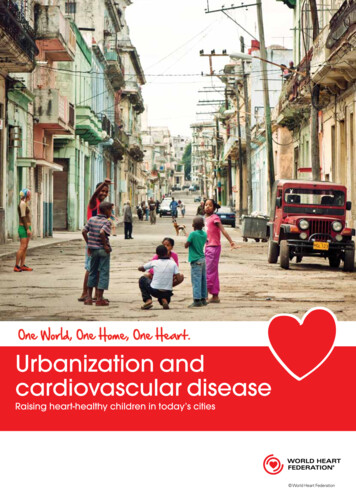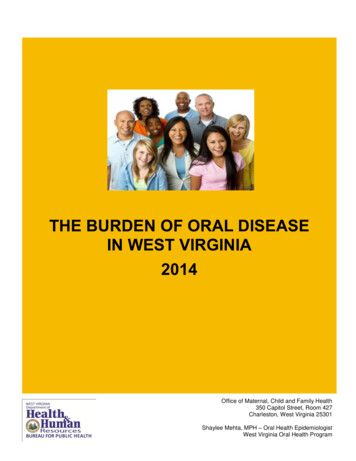
Transcription
THE BURDEN OF ORAL DISEASEIN WEST VIRGINIA2014Office of Maternal, Child and Family Health350 Capitol Street, Room 427Charleston, West Virginia 25301Shaylee Mehta, MPH – Oral Health EpidemiologistWest Virginia Oral Health Program
AcknowledgementsAuthorShaylee Mehta, MPHOral Health EpidemiologistBurden of Oral Disease:Tool for Creating State DocumentsAuthors of the toolContent Contributors and ReviewersJason Roush, DDSState Dental DirectorScott L. Tomar, DMD, MPH, DrPHUniversity of Florida College of Dentistry,Associate ProfessorTeresa Marks, BAOral Health Program, Interim Manager,Workforce CoordinatorBeth Hines, MPH, RDHCDC Division of Oral Health, Public HealthEducatorChristina Mullins, MAMaternal, Child and Family Health, DirectorLisa R. Levy, MPHAssociation of Schools of Public Health, FellowKathy Cummons, MSW, ACSWResearch, Evaluation and Planning, DirectorContributors to the toolMelissa Baker, MAMaternal, Child and Family Health, SeniorEpidemiologistChildren’s Dental Health ProjectBobbi Jo Muto, MPH, RDHMarshall University School of Medicine - Robert C.Byrd Center for Rural Health, Community OralHealth CoordinatorAssociation of State & Territorial DentalDirectorsColorado Department of Public Health,Oral Health ProgramMichigan Department of Community HealthMississippi Health Policy and Research CenterDeonna Williams, MS, CHESWV Oral Health Coalition, Coordinator,Oral Health Program, Former ManagerBirgit Shanholtzer, MAWV Health Statistics Center/Vital, SeniorEpidemiologistFundingFunding was made possible by cooperativeagreement CDC DP13-1307 from the Centersfor Disease Control and Prevention (CDC).Candace Vance, RNWV Children’s Health Insurance Program,Health Benefits and Claims AnalystSuggested CitationMehta S. (2014). The Burden of Oral Disease inWest Virginia. Charleston, WV: West VirginiaOral Health Program, WV Department of Healthand Human Resources.Kathy Phipps, DrPHAssociation of State and Territorial DentalDirectors, EpidemiologistContactFor questions regarding this report, contactShaylee Mehta, at shaylee.p.mehta@wv.gov.
Table of ContentsExecutive Summary . 1Background . 5National and State Oral Health Objectives . 7The Burden of Oral Diseases . 9Prevalence of Disease and Unmet Needs . 9Children . 9Adults . 11Disparities .16Racial and Ethnic Groups . 16Women’s Health . 16People with Disabilities . 17Socioeconomic . 17Geographical . 18Societal Impact of Oral Disease .18Social Impact . 18Economic Impact . 18Oral Disease and Other Health Conditions . 20Risk & Protective Factors Affecting Oral Diseases . 21Community Water Fluoridation .21Topical Fluorides and Fluoridation Supplements .21Dental Sealants.22Preventive Visits .24Children . 24Adults . 25Pregnant Women . 26Screening for Oral Cancers .27Tobacco Control .27Youth . 28Adults . 30Oral Health Education .32Provision of Dental Services . 33Dental Workforce and Capacity .33Distribution of Dental Workforce in West Virginia . 33Increasing Access to Dental Services . 34Growth in the Demand of Dental Professionals in West Virginia . 35Dental Education Institutions. 37
Dental Workforce Diversity .39Use of Dental Services .40General Population . 40Special Populations . 41Dental Medicaid and State Children’s Health Insurance Program (CHIP) .43Community & Migrant Health Centers and Other State, County & Local Programs .46Community-Based Health Centers . 46Emergency Departments and Hospitalization . 47School-Based Health Services. 49West Virginia Oral Health Program (OHP) . 49Conclusions & Future Considerations . 51References . 52Appendix . 56
Executive SummaryIntroductionThe mouth is our primary connection to the world. It serves to nourish our bodies as we take inwater and nutrients to sustain life. It is our primary means of communication, the most visiblesign of our mood, and greatly influences how we are perceived by others. Oral refers to thewhole mouth: teeth, gums, hard and soft palate, linings of the mouth and throat, tongue, lips,salivary glands, chewing muscles, and upper and lower jaws. Therefore, the mouth is anintegral part of the human anatomy and plays a major role in our overall physiology, making oralhealth intimately related to the health of the rest of the body.Manifested in poor nutrition, school absences, missed workdays, and increasing public andprivate expenditures for dental care, the burden of oral disease is overwhelming. Ranging fromcaries to cancers, poor oral health causes unnecessary pain, suffering, and disabilities forcountless Americans.Not only does good oral health mean being free of tooth decay and gum disease, but it alsomeans being free of chronic oral pain conditions, oral cancer, birth defects such as cleft lip andpalate, as well as other conditions that affect the mouth and throat. Similarly, changes in themouth are often the first signs of problems elsewhere in the body, such as infectious diseases,immune disorders, nutritional deficiencies, and cancer. Current research suggests thatperiodontal (gum) diseases increase the risk of heart disease, put pregnant women at greaterrisk of premature delivery, respiratory infection in susceptible individuals and complicate controlof blood sugar for people living with diabetes.16 Good oral health helps ensure overall healthand well-being. It is dependent on a variety of factors including diet, oral hygiene and otherlifestyle choices, as well as community-based preventive interventions and access toprofessional dental services.As age increases, the burden of untreated disease does as well. Caries can result in acute orchronic pain, dental abscesses, infections, and tooth loss. Though this disease is largelypreventable, the repercussions may be extreme if care is not sought out in a timely manner.The childhood years are the optimum time for preventive measures. Many adults struggle withoral health care due to a number of barriers, including inconvenient timings for dentalappointments, lack of insurance coverage and more.The Oral Health Program (OHP) of the State of West Virginia seeks to reduce dental diseaseand improve the oral health of West Virginia citizens by planning, implementing, and evaluatingoral health promotion and disease prevention programs. The purpose of this report is to providean overview of current available information concerning the burden of oral disease among thechildren and adults of West Virginia. This report can only present our best efforts at representingoral health in West Virginia. One shortcoming is the time lag in data availability. Some of thedata presented is several years old. The degree of time lag differs across information sources.This report summarizes the most current information available on the oral disease burden ofpeople in West Virginia. Comparisons are made with national data whenever possible and toHealthy People (HP) 2020 Objectives when appropriate. This summary of the oral healthdisease burden should help raise awareness of the need for monitoring the oral health burden inWest Virginia and guide efforts to prevent and treat oral diseases and enhance the quality of lifeof West Virginia’s residents.WVDHHR/BPH/OMCFH/REP/OHP/BURDEN 2014Page 1
MethodData in this report includes surveillance indicators that were outlined in the West Virginia OralHealth Surveillance Plan. Indicators represent five domains:1) Oral disease: includes dental caries, tooth loss, periodontal disease, oral and pharyngealcancer, and cleft lip/palate;2) Prevention: includes dental screenings, cleaning, sealants, and water fluoridation;3) Risk factors: includes tobacco use;4) Access to care: includes recent dental visits, receipt of needed care, reasons for notreceiving care, dental insurance, and Medicaid and Children’s Health Insurance Program(CHIP) claims; and5) Dental health workforce: includes dental professions (dentists and hygienists), schoolbased programs, and community health centers with oral health components.This report used The Burden of Oral Disease: A Tool for Creating State Documents provided bythe Centers for Disease Control and Prevention (CDC) as a reference guide. Indicators arereported for the most recent year of data available; trend data is also reported for a smallnumber of key indicators. Select indicators are presented for demographic subgroups.Use for Program DevelopmentThis report was created to provide oral health related data to members of the oral healthworkforce, public health professionals, legislators and others engaged in maintaining andimproving oral health in West Virginia. This information is necessary to develop and guide publichealth activities, monitor and evaluate progress and identify disparate population groups.Moreover, data presented in this report can support the establishment of new prioritiesregarding surveillance.Key FindingsTooth Decay Among West Virginia Children West Virginia children have significant experience of tooth decay. During the 2010-2011school year, a statewide survey showed that 34% of the universal Pre-K population hadexperience with caries, while 3rd grade children had a prevalence of 42% for cariesexperience. More recent data from the 2013-2014 school year show this prevalence in 3rdgraders to have increased to 56%. This may be in part due to better surveillance effortsduring the 2013-2014 school year. Untreated dental decay among the universal Pre-K population showed a prevalence of 21%,while 3rd grade children observed a prevalence of 17.1% during the 2010-2011 school year.Findings from the 2013-2014 oral health survey showed an increase in decay to 21% among3rd graders. This may be in part due to better surveillance efforts during the 2013-2014school year. During the 2012-2013 school year, Marshall University - School Sealant Program showedchildren and adolescents who have not visited the dentist in more than one year are moresusceptible to untreated tooth decay than those who have visited the dentist in the past year(62.4% vs. 37.6%, respectively).WVDHHR/BPH/OMCFH/REP/OHP/BURDEN 2014Page 2
Tooth Loss Among West Virginia Adults Though some improvement has been observed in the extent of tooth loss among adultssince the late 1990s, in 2010, over half (64.9%) of adults aged 18 years had at least onepermanent tooth extracted; among the adult population aged 65 years, 33.8% hadexperienced complete edentulism (loss of natural teeth). By 2012, 12.4% of all adults aged18 years were completely edentulous. This may be in part due to improvements insurveillance efforts in 2012. In 2011, 28.6% of adults aged 18 years used some form of tobacco (cigarettes, chewing,snuff, and dip). Negative correlations were seen between education level and the prevalence of completetooth loss among West Virginia adults aged 65 years. As education level increased, theprevalence of complete tooth loss decreased. A similar relationship was observedconcerning household income (HHI).Oral and Pharyngeal Cancer in West Virginia From 2006-2010, the age-adjusted incidence rate for oral and pharyngeal cancer amongWest Virginians was 11.4 per 100,000 population, whereas the U.S. rate was 10.8 per100,000. From 2000-2010, the average annual mortality rate for oral and pharyngeal cancer amongWest Virginians was 2.8 per 100,000 population, similar to the U.S. average.Preventive Oral Health Services In 2012, half of West Virginia adults (53.3%) aged 18 years had visited a dentist in the last12 months. In 2012, 1 in 5 (22%) adults had not visited a dentist in over five years. In the 2010-2011 school year, 3 out of 10 (29%) 3rd graders in West Virginia had dentalsealants on their permanent molars, slightly increasing (32%) during the 2013-2014 schoolyear. This may be in part due to better surveillance efforts during the 2013-2014 schoolyear. Nationally, in 2009-2010, 32.1% of children aged 6-9 years had dental sealants ontheir permanent molars. As of 2012, 91.1% of West Virginians served by community water systems (CWS) werereceiving fluoridated water.Access to Dental Care In 2012, only 40% of adults in West Virginia had dental coverage.o Although 81% reported some type of medical coverage, only 43% had an option topurchase supplemental dental coverage with their existing plan. In 2012, 16% of West Virginia adults could not access care when needed over the past 12months.o The top two reasons reported for lack of access were no insurance and not being ableto afford it.Dental Health Workforce West Virginia has less dentists per capita than the U.S. overall; in 2012, West Virginia had4.7 dentists per 10,000 population, while the U.S. overall had 6.2 dentists per 10,000population. By 2014, there were 922 active, licensed dental hygienists working in West Virginia. West Virginia’s dental workforce is aging, and until more recently, there has been adecreasing trend in the retention of dental professional graduates in the state. This lack indental care providers contributes to the limitations in access to care.WVDHHR/BPH/OMCFH/REP/OHP/BURDEN 2014Page 3
ConclusionsAlthough there have been some improvements in the oral health of West Virginia’s residentsthroughout the years, there are many areas of need. The data presented indicates severalspecific areas that require increased focus to address the burden of oral disease, as well asfurther analysis and program development. These include the following:1) Lack of access to care is common, and associated with significant untreated tooth decayamong West Virginia adults.2) Large socioeconomic disparities in oral health exist; these are observed in cariesexperience among children and edentulous among adults.3) Tobacco use is a major risk factor for the development of oral disease.4) Analysis of the dental workforce will be imperative in assuring adequate access to carefor West Virginians, as well as improving the oral health status.Increased efforts in control and surveillance of oral disease and conditions, preventiveinterventions, workforce development and distribution of oral health care professionals are keyelements in improving and maintaining the oral health status of West Virginians.WVDHHR/BPH/OMCFH/REP/OHP/BURDEN 2014Page 4
BackgroundWest Virginia DemographicsWest Virginia is the second most rural state in the nation and is the only state located entirelywithin the area known as “Appalachia.” West Virginia reached its population peak a half centuryago with 2,005,552 residents counted in the 1950 U.S. Census. The State's population has notexceeded the 2 million mark since then, but has fluctuated between 1.7 and 1.9 milliondepending on the State's economy. Four of the State's five largest cities have lost populationsince 1990. Charleston, the state capitol and largest city, and Huntington are the only cities withpopulations exceeding 50,000 people. Two-thirds of the State’s 1.8 million people live incommunities with less than 2,500 residents; 44 of the 55 counties in West Virginia aredesignated as non-metropolitan by the Federal Office of Management and Budget and 49counties are designated fully or in part as Health Professional Shortage Areas (HPSA) and/orMedically Underserved Areas. Chronic conditions are more prevalent among rural populations,with nearly half (46.7%) of the adult, rural population having one or more chronic conditionscompared with 39.2% in urban areas. According to the Rural Health Research Center, ruralpopulations have fewer dentists, lower dental care utilization and higher rates of dental cariesand permanent tooth loss than urban populations. Reports from the Surgeon General call formore dentists in rural populations.Appalachia is distinguished by mountainous terrain, geographic isolation and a history ofeconomic underdevelopment. Although conditions in Appalachia have improved in recent years,these improvements have not benefited all communities equally. Isolated, rural areas continueto experience the most adverse social, economic and educational deficits, resulting in significanthealth disparities in the incidence, prevalence, mortality, burden of chronic diseases and theirrisk factors, as well as access to care. Not surprisingly, West Virginia consistently ranks in thetop three nationally in adults self-reporting their general health as either “fair” or “poor.” Dataindicates that 18% of individuals could not afford needed health care services andapproximately 21.4% of adult West Virginians do not have a specific personal doctor or healthcare provider.According to 2010 U.S. Census Bureau data, the State’s population is predominantly White(94.1%) with other racial and ethnic minorities being primarily Black/African American (3.5%),Hispanic or Latino (1.3%), Asian (0.7%) and Native Americans (0.2%). West Virginia has thesecond highest percentage of its population over age 65 (15.8%) and the fifth highestpercentage of its population living at or below the poverty level (17.6%). According to the 2000U.S. Census Bureau, 22.5% of the population 16-64 years of age had a disability and 13.2%had a work disability. In terms of education, West Virginia ranks 36th in the percentage of itsadults aged 25-64 with at least a high school diploma (86.0%), 50th in the percentage of adultsaged 25-64 with a bachelor’s degree or higher (18.7%) and 44th in the percentage with agraduate or professional degree (7.3%). West Virginia is consistently near the top in rankings ofstates with a prevalence of heart disease, diabetes and other chronic conditions. Yet with all ofthese challenges, West Virginia has a diverse and well-developed system of community healthpartners consisting of hospitals, community health centers, local health departments, agingprograms, academic health institutions, teaching programs and non-profit organizations that,when working together, support and strengthen health improvement efforts.Data SourcesData for this report were obtained from multiple sources, including written surveys, dentalscreenings and sealants databases, insurance claims, emergency department visit records,cancer incidence reports, death certificates, and professional licensure databases. The specificWVDHHR/BPH/OMCFH/REP/OHP/BURDEN 2014Page 5
data sources used are described in the Appendix located at the end of the report. For eachdata source, information on the purpose of data collection, population sampled, data collectionmethods, and frequency of data collection is provided.Additionally, it is important to note that all data have limitations, and this report can only presentbest efforts at representing oral health in West Virginia. One weakness is the time lag in dataavailability. Some of the data shown are several years old since the degree of time lag differsacross information sources and data presented are often from different time periods. However,for the data to have significance, efforts have been made to keep variations in time as limited aspossible.Another limitation is our inability to present statistics for some important subgroups. Comparedto many areas of the U.S., West Virginia is relatively homogenous with respect to race/ethnicity.The State generally lacks sufficient numbers to allow significant and stable comparisons acrossracial/ethnic groups. Nevertheless, there should be no reason to believe the racial/ethnicdisparities that have been well-documented nationally do not apply to West Virginia. Similarly,data concerning subpopulations that may require special attention in public health practice arealso lacking, such as those with disabilities.WVDHHR/BPH/OMCFH/REP/OHP/BURDEN 2014Page 6
National and State Oral Health ObjectivesOral Health in America: A Report of the Surgeon General alerted Americans to the importanceof oral health in their daily lives.46 Issued in May 2000, the report further detailed how oral healthis promoted, how oral diseases and conditions are prevented and managed, and what needsand opportunities exist to enhance oral health. Its message was that oral health is essential togeneral health and well-being and can be achieved. However, several barriers hinder the abilityof some Americans to attain optimal oral health. The report concluded with a framework foraction, calling for a national oral health plan to improve quality of life and eliminate oral healthdisparities.One component of an oral health plan is a set of measurable and achievable objectives on keyindicators of oral disease burden, oral health promotion, and oral disease prevention. One set ofnational indicators was developed in November 2000 as part of Healthy People 2010, adocument that presents a comprehensive, nationwide health promotion and disease preventionagenda.47 Healthy People 2020 is designed to serve as a roadmap for improving the health ofall people in the U.S. during the second decade of the 21st century. Included are objectives forkey structures, processes, and outcomes related to improving oral health. These objectivesrepresent the ideas and expertise of a diverse range of individuals and organizations concernedabout the nation’s oral health.The Surgeon General’s report on oral health was a wake-up call, spurring policy makers,community leaders, private industry, health professionals, media, and the public to affirm thatoral health is essential to general health and well-being and to take action. That call to action leda broad coalition of public and private organizations and individuals to generate A National Callto Action to Promote Oral Health.48 The vision of the Call to Action is “To advance the generalhealth and well-being of all Americans by creating critical partnerships at all levels of society toengage in programs to promote oral health and prevent disease.” The goals of the Call to Actionreflect those of Healthy People 2020: To promote oral health To improve quality of life To eliminate oral health disparitiesNational objectives on oral health such as those in Healthy People 2020 provide measurabletargets for the nation, but most core public health functions of assessment, assurance andpolicy development occur at the state level. The National Call to Action to Promote Oral Healthcalls for the development of plans at the state and community levels, with attention to planning,evaluation and accountability.48 The Healthy People 2020 oral health objectives for the nationand the current status of each indicator for the United States and for West Virginia aresummarized in Table 1.WVDHHR/BPH/OMCFH/REP/OHP/BURDEN 2014Page 7
Table 1.Healthy People 2020 Oral Health Indicators, Target Levels, and Current Status in theU.S. and West VirginiaHealthy People 2020 ObjectiveOH-1: Dental caries experienceChildren aged 3 – 5 yearsChildren aged 6 – 9 years*Adolescents aged 13 – 15 yearsOH-2: Untreated caries (tooth decay)Children aged 3 – 5 yearsChildren aged 6 – 9 years*Adolescents aged 13 – 15 yearsOH-3: Adults with untreated dental decayAdults aged 35 – 44 yearsAdults aged 65 – 74 yearsAdults aged 75 years and olderOH-4: Permanent tooth lossAdults aged 45 – 64 years (any)Adults aged 65 – 74 years (lost all teeth)OH-5: Destructive periodontal diseaseAdults aged 45 – 74 yearsTarget (%)NationalStatusa (%)(NHANES1999-2004)West VirginiaStatus 8n11.512.8bDNCC-6: Oral & pharyngeal cancer death rates reduction (per 100,000population)OH-6: Early detection of oral & pharyngeal cancers2.32.52.6l35.831.2eDNCOH-7: Use of oral health care system; all ages49.041.8iDNCOH-8: Dental services for low-income children & adolescents33.235.2gDNCOH-10: Health Centers with oral health componentOral health care program at Federally Qualified Health CentersOral health prevention or care programs at local health 11.1c10.113.432.129.2c34.133.320.5jDNCOH-9: School-based centers with an oral health componentDental SealantsDental CareTopical FluorideOH-11: Receipt of oral health services at health centersOH-12: Dental sealantsChildren aged 3 – 5 years on 1 or more primary molarChildren aged 6 – 9 years on 1 or more permanent molar*Children aged 13 – 15 years on 1 or more permanent molar1.51.4DNA28.132.1f32.0k21.950.5fDNCOH-13: Community water fluoridation79.672.4d91.1oOH-14: Preventive dental screening & counseling (Developmental)DNADNADNADNA51 (50 states &the District ofColumbia)DNADNA32 stateseYesOH-15: Systems that record cleft lip/palate & referrals (Developmental)OH-16: Oral & craniofacial state-based health surveillance systemOH-17: Health agencies with a dental professional directing dental programStates & local health agenciesIndian health service areas & Tribal health programs25.723.4d1mg12 programs11 programs1m*West Virginia collects data on 3 graders, whereas Healthy People 2020 & National data reports children aged 6-9 years old.DNA Data Not Available; DNC Data Not Collected (at this time); aData from 1994-2004, unless otherw
1) Oral disease: includes dental caries, tooth loss, periodontal disease, oral and pharyngeal cancer, and cleft lip/palate; 2) Prevention: includes dental screenings, cleaning, sealants, and water fluoridation; 3) Risk factors: includes tobacco use; 4) Access to care: includes recent dental visits, receipt of needed care, reasons for not
